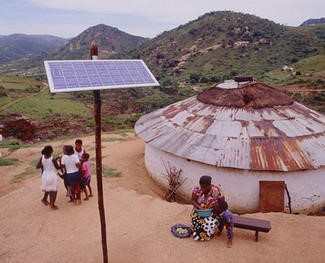Resource 6: Generating electricity in Africa
![]() Background information / subject knowledge for teacher
Background information / subject knowledge for teacher
Generating electricity in Africa
You can use this information to create some posters that your students can refer to during the lesson.
Africa, as a continent, has huge natural fuel resources.
Fossil fuels include gas, oil and coal. New reserves are being found all the time, but once they have been used up they cannot be replaced. A recent discovery is the presence of gas under the sea bed, off the coast of Tanzania.
Fossil fuels are burnt to produce heat, which is used to heat water to generate steam to drive a turbine. In the process, carbon dioxide and other acidic gases are given off which can cause global warming and acid rain. Also, oil and gas have other uses, as a source of petro-chemicals, so it could be argued that they should not be burnt. However, fossil fuels are relatively cheap and burn to produce a lot of heat.
In addition to fossil fuel resources, the continent has huge potential for the development of alternative energy schemes based on renewable sources of energy.
Geothermal energy
The Rift Valley, which stretches south from Syria to Mozambique, has been targeted by the Kenya Electricity Generating Company (KenGen) as a site for one of the world’s largest geothermal energy projects.
The $1. 3bn (£830m) project, to develop 280 MW of geothermal power by 2013, is expected to be backed by the World Bank and will more than double KenGen's geothermal capacity.
http://www.businessgreen.com/ bg/ news/ 1804505/ kenya-tap-rift-valleys-geothermal-gold [Tip: hold Ctrl and click a link to open it in a new tab. (Hide tip)] .
In this system, steam-gathering machines are used to drill down into the Earth’s crust and the steam that occurs naturally underground in some places (notably places where there are also volcanoes) is brought to the surface and used to drive turbines. There is very little pollution, but the system is expensive to install. It only works in certain places.
Hydroelectric power
Africa also has some of the largest rivers in the world that lend themselves to the utilisation of micro-hydro-power plants. A section through a typical installation is shown below. Hydro electric power uses gravity. Water, falling from a significant height, or flowing fast, is used to drive a turbine which produces electricity.

In fact, it has been claimed that such installations on the ‘Niger, Senegal, Congo, Orange, Limpopo, Volta and Zambezi rivers can generate enough electricity to meet all of Africa’s energy needs.’ (http://www.desertec-africa.org/ index.php?option=com_content&view=category&id=2&layout=blog&Itemid=2)
Wind power
Wind turbines can be installed in areas where the wind is reliable. The wind drives blades which in turn cause a conductor to move in a magnetic field, which generates electricity. They are expensive to build and quite a lot of turbines are needed to produce reasonable amounts of electricity. Some people complain about the appearance and the noise that they make, but they don’t produce any fumes or ash.

Solar power
also enjoys a great deal of sunshine and it is solar energy that produces, potentially, the greatest output of electricity through photovoltaic cells and concentrated solar power (CSP). Whereas PV converts the sun’s light directly into electricity, CSP concentrates the sun’s light, using mirrors that track the trajectory of the sun through the sky from sunrise to sunset, in order to heat water to produce steam that powers turbines and generates electricity. Again, it can be expensive to set up a solar energy plant, but once it is running, the costs are low. Solar panels are also quite delicate and susceptible to damage if not properly installed.

Many organisations in Africa have small diesel generators in order to compensate for unreliable supply from power stations. These use fossil fuels and therefore produce greenhouse gases.
| Diesel generator | Solar panels | |
|---|---|---|
| Initial price (very approximate) | £1000 | £20 000 (to produce 5kW) |
| Output | 5kW/230V | Variable – depends on the number of panels |
| Cost of diesel | £1. 40 per litre | NA |
| Amount of fuel used | £1 litre per hour | NA |
| Advantages | 5 kW is enough to run multiple items Relatively cheap to buy and install | No running costs other than maintenance No fuel costs Africa generally has a lot of sun and the sun is overhead Used to charge batteries so electricity is available after dark |
| Disadvantages | Noisy Can be unreliable if not properly maintained Price of diesel varies Produces CO2 and fumes | Very expensive to install Fragile – need to be on a roof or fenced in Low wattage produced |
Questions you could use to structure the task for children who might need help
If the diesel generator ran for 4 hours a day, how much diesel would be used each day?
How much diesel would be used in a year?
How much would this cost?
How many years would it take reach a total cost of £20 000 (the cost of solar panels)?
Resource 5: Teacher’s notes for investigating fuels



